
All images below are thumbnails only; Full versions may been seen in the SimHQ article.
Q & A
Major Ed Rasimus (USAF, Ret.)
F-105 and F-4 Pilot
by John
"Spoons" Sponauer
Originally
Published October 30, 2002 at

All images below are thumbnails only; Full versions may been seen in
the SimHQ article.
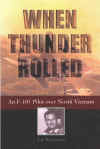
In my opinion, there are some eras of aviation history that stand out for the horrible conditions, attrition, or combat suffered by those fighting it. The RAF pilots in the Battle of Britain, for instance, with their nonstop tempo, the USAAF heavy bombers in the fall of 1943 with their atrocious losses, or the pilots on WWII's Eastern Front, with subzero temperatures and brutal fighting. There are such stories in all wars as well, of course, and one of them from America's war in Vietnam were the Thud drivers during Operation Rolling Thunder, who suffered astoundingly high casualties in a combat situation entangled with political constraints. Ed Rasimus completed a combat tour in the F-105 during the early days of Rolling Thunder, and then went on a second tour six years later as an F-4 Phantom pilot. Ed was nice enough to take the time and answer some questions for us about "When Thunder Rolled," his war experiences, and much more.
I would be remiss if I didn't thank Andy Bush and "Chunx" from SimHQ for his extensive help in providing questions for Ed, and suggestions for how to make this interview even better.
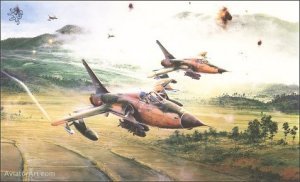
"Rolling Thunder" by Robert Taylor
(Courtesy
of AviatorArt.com)
BACKGROUND
How did you become interested in flying first of all, and then later decide on the USAF?
I’m one of those fortunate folks that knew at a very early age what I wanted to do when I grew up. I built model airplanes as a kid, mostly flying models, but a lot of plastic stuff as well. Those were the wild days of first generation jets like the F-80, 84, 86, 89 and then the wild Century Series. It was an exciting time in aviation. By the time I was in high school, I knew I wanted to be a military pilot and that virtually defaulted to USAF. I don’t ever recall, even once, considering the Navy. The AF Academy had just started up and when I was graduating from high school, class of ’60, I applied. I wasn’t very knowledgeable about the politics of the process and didn’t have any family background in the AF, so I didn’t make it. I fell back on plan B and chose a college with AFROTC. I applied again in ’61 and got selected for AFA, but chose to stay in college. I started flying J-3 Cubs at a local airport and got my private pilot license, graduated from college and got commissioned in the AF all about the same time.
How did you wind up in fighters? F-105s?
Assignment out of UPT was based on class standing. There were eight UPT bases with a class graduating every six weeks. Assignments were based on the needs of the AF and covered all the systems currently flying. When I graduated there were 325 slots, but only nine F-105s and five F-100s. I was very fortunate to get my first choice. Of the nine guys in my class for F-105 training, four of the nine were first in their graduating class at their base.
I had wanted to fly the 105 from the first time I saw one. I’d been on a base visitation with my ROTC unit to Nellis AFB in ’62. The airplane was awesome. Nothing else ever appealed to me from that point on. It should be noted, however, that there was no war on at the time and it was strictly a matter of the biggest, baddest, fastest, most boss machine in the inventory.
What was your rank and ground job in the USAF? What were your duties when not flying?
I went to 105 training right out of UPT. I was a 2/Lt until halfway through training and a 1st Lt during my combat tour. By “ground job” I assume you mean my additional duty. Everyone has to have an additional duty but it often isn’t much of a job. As a 1/Lt in a combat fighter squadron I was the “Mobility & Plans Officer.” That meant I was responsible for coordinating the deployment of the squadron to a combat location. Since we were already in a war, it really meant that I kept a manila folder that had a list of the 75 or so squadron mobility bins and what was supposed to go in each one. We weren’t going anywhere, so I simply flew missions.
Do you still fly?
Nope. My last flying assignment was training
instructor pilots at Fighter Lead-In, the AT-38B program at Holloman. I
don’t fly light planes and I never had the urge to go to the airlines. I
often tell folks that wonder about airline jobs that it would be like asking
Mario Andretti if he intended to drive for Greyhound after he gave up racing.
There’s really no kick available in the non-military, non-combat world like
flying top of the line fighters.
THE VIETNAM WAR AND AIR COMBAT

USAF bases in Thailand
Your book, “When Thunder Rolled,” exclusively focuses on your first 100-mission tour over Vietnam….flying the F-105 out of Korat, Thailand during Operation Rolling Thunder. Please tell us a little bit about your living and working quarters at Korat. How about during your second tour?
By May of ’66 when I arrived at Korat, the facilities were pretty good. The squadron building was a permanent, air-conditioned, teak wood structure. The crew quarters were bungalows built on a quadrangle. There was a central shower/latrine in each building with a small screened sitting area, then four, two-man rooms—two on each side of the central shower area. The rooms were air-conditioned with two single beds, a small closet, two desks and two small dressers. Each building was assigned to a flight within the squadron, so you’d have the flight commander and the wingmen of a flight living in proximity.
The Officer’s club was air-conditioned, spacious and with reasonable bar and restaurant facilities. Booze was cheap—Johnny Walker Black, Beefeater Gin, Smirnoff Vodka and Crown Royal were the well booze and drinks were 35 cents. The club food was adequate, nothing fancy and poorly cooked. Shortages of items were common and it became a joke to refer to the menu as the “no hab” list. There was a small BX down the street from the club, but it seldom had much to choose from. Toothpaste, razor blades and soap were the main commodities. We had a small Thai souvenir shop near the club that offered teak elephants, brass tableware and cheap jewelry. There was also a Thai tailor shop that sold us our “shit hot” jungle hats and did tailoring of uniforms and sewing on of patches.
My second tour in ’72 was “déjà vu all over again.” I lived in a hootch (building) about forty yards from where I lived during my first tour. In fact, the hootch maid who did the laundry, cleaned and made the beds on my first tour was still working in the same hootch.
The squadron building was a lot more crowded in ’72 since we had a lot more crews and a two-place airplane. The O’Club was a newer and larger building with its own swimming pool. The BX was a huge place with stereos, appliances, clothing and more. The Thai tailors now made custom clothing, created a wide variety of novelty (and often obscene or scatological) patches and the entire operation wasn’t much different than a stateside base. I’m planning to address a lot of these changes in the war and the attitudes in the second book describing the F-4 experiences during Linebacker I & II.

Korat Royal Thai Air Force Base
How big were your units, in personnel and aircraft?
An F-105 operational squadron consisted of eighteen aircraft and twenty pilots. We lost just over 100 F-105 aircraft during the period of my combat tour—that’s from 3 squadrons at Tahkli and initially 2, then growing to 4 squadrons at Korat. Roughly 100% of the airplanes from the two wings lost in just over six months. Our schedule was typically eighteen lines a day, so that means everybody flew once. With losses, it was occasionally tough to fill the schedule. Of course, there were a small number of wing staff pilots that helped the squadrons by flying a couple of times per week.
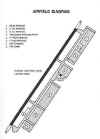
Runway layout of Korat
Can you describe the typical target sets you saw in your missions?
The whole concept of Rolling Thunder was one of gradual escalation. When I arrived in May of ’66, we were seeing a couple of Pack VI (Red River Valley) targets per week. They were drawn from a JCS-approved target list and struck until destroyed. By the end of June, the escalation went to daily Pack VI targets. The weather was always a factor and the typical target package would be three levels of approval. We’d have a Pack VI target primary, then a lower route pack target as a secondary back up if weather was bad, and finally an armed recce tasking over a route segment somewhere in Pack I or Laos.
Primary targets were things like bridges, storage areas, POL (Petroleum, Oil & Lubricants) areas or line of communication choke points. We were prohibited from striking the MiG bases at Kep and Phuc Yen in ’66.
There was a lot of frustration about targeting since the Rolling Thunder concept of escalation meant that there was an appearance of only minimal intention of hurting the enemy. Lots of bombs were dropped on dirt roads, stream fords, suspected truck parks and just plain jungle.

Korat F-105 arming
What was mission planning like? Can you walk us through the basics from receiving the frag to stepping to your jet? Did the mission planners fly their own missions? Did you ever get last-minute changes to the plan as you were stepping? How did the mission planning in the F-105 vary from the Wild Weasel-related missions in the F-4?
The “frag”is a fragment of the total day’s operations plan. It is the part that one wing gets. Typically the frag would arrive in the afternoon of the day before. Wing planners would break out the missions and targets then allocate to the squadrons. The squadron scheduler would get a list of T/O times, target route packs (but not specific targets usually), refueling tracks, and weapons loads. The scheduler would then assign people to lead, wing, and element positions. Of continual concern was load or threat sharing. Everyone was always watching for “good” and “bad” deals. It was a balancing act between too much threat and too much glory. It was considered good to get a shot at a decent and valuable target, but it was a bad deal to be placed too much at the pointy end of the spear, particularly if it looked like some were being spared exposure.
Much has been made regarding the “mandatory” routing or timing from 7th AF. While timing was fixed, there really wasn’t a whole lot of flexibility if you were going to get two strike packages a day during daylight hours. Loading, refueling, minor fixes and the required post and pre flight inspections required a fixed time. Current ops with night and all-weather capability make for a better list of tactical options. Hot-pit refueling and pre-configured loads also weren’t in the bag of tricks at the time. As for routing, NVN isn’t that big a country and there aren’t that many ways in and out. Flight leads got quite a bit of latitude with regard to delivery tactics as well as ingress/egress altitudes and formation.
Especially related to your F-105 tour, how did you ingress the target - altitude, speed, formation. Did you use ECM? Any special procedures? For example, I once read that some F-105 guys dumped cabin pressure prior to entering the defended area.
I flew the 105 in combat from May to November of ’66. During that time, we were just getting the APR-25/26 RHAW gear. We did not get the first ECM pods (QRC-160) until late October and I never carried a pod in the F-105.
Tactics changed (that’s the essential definition of tactics) with time. A lot of missions when I first arrived were flown at low level—tree-top ingress. At Korat we began to fly higher—generally around 4,500’ AGL. This allowed for easier navigation, seeing landmarks and finding the target as well as better lookout. It kept us out of small-arms fire and yet still allowed for a quick dive down into ground clutter or terrain masking for SAM avoidance. Weapons delivery was 30 or 45 degree dive bomb, so it required a pop-up to delivery altitude but the three-dimensional maneuvering of pop, roll, pull-down and dive-bomb was hard for gunners to track.
Speed was always in a multiple of 60—easy calculation of miles/minute. Cruise in would be at 480 or 540 ground speed—eight or nine miles/minute. We would usually push up to 600 for the final run in.
Formations were a tactical spread, usually level at low altitude and stacked 1,500 feet high or low at high altitude. Wingmen would be 2,500-3,000 feet off their leader and 0 to 30 degrees back from line abreast. The element would be 4,000-6,000 feet out, stacked and 0-30 back from line abreast. Our squadron really stressed that the wingmen should always be easily visible to the leader and that formation integrity was paramount. It’s damn tough to make a check turn coming off the target to let the flight get back into your tactical spread when every fiber of your being is screaming, “let’s get out of here.” But, we found out quickly that formation support paid off.
Dumping cabin pressure in the combat area was a checklist item. The principle was that since cabin pressure and air conditioning came from compressor bleed air off the engine, if you took a hit and got an engine fire you'd get a flash back into the cabin. There's also the issue of blowing on any fire or sparking in the cockpit, so the "book" solution was to go RAM as part of your IP check. Since it meant losing air conditioning and since we were daily gaining experience about what the airplane did when hit, a lot of guys began to take the chance and leave the air conditioning on.

"Jaws of the Dragon" by Stanley
Stokes
(Courtesy
of AviatorArt.com)
How did NVAF air defenses effect or alter your tactics? What were the NVAF air defenses like in 1966? Later in the war, when you were flying F-4’s?
In the summer of ’66 the major news magazines like Time and Newsweek were already referring to the area around Hanoi as “the most heavily defended in the history of aerial warfare.” The SA-2 was the new threat and it was significant, both psychologically and in terms of its effect in the integrated air defense. Most losses were to guns, but the SAM forced you lower and that meant more guns had a shot at you.
Guns ranged from peasants with rifles to automatic weapons like heavy machine guns to heavy AAA. The anti-aircraft guns in ’66 were mostly 37/57mm fired in barrage sectors and 85mm fired optically or with FireCan radar guidance. Intel reported guns as big as 100 and 130mm but there was no way to distinguish in flight from the 85s.
MiGs flew occasionally and were always a threat. There were a lot of ‘17s and some ‘21s in ’66. A lot is made of the kill ratio during Rolling Thunder, but the fact is that there weren’t many opportunities. The MiGs flew to disrupt the bombing flights and the 105s primary job was to deliver iron on targets.
During Linebacker, the threat had shifted. There were a lot more SAM sites, a lot more MiGs and a lot more mobile triple A. There were fewer 37/57 and I don’t recall seeing much 85mm flak during ’72 but there were a lot of high-speed 23mm guns. We were better equipped, with good radar coverage from Disco and Red Crown plus we had Combat Tree for the specialists out of Udorn. The 105G Weasel was much better able to detect and discriminate enemy radars and the Shrike had really improved. We used a lot of chaff, dropped in corridors to support the bomb flights and we had much improved pods and RHAW. Losses in Linebacker, while still considerable, were much lighter than during ’66 and ’67 in Rolling Thunder.
Did you ever engage a MiG? See one? Any buddies who did? Any eyewitness accounts?
There are a couple of MiG encounters in my book. I nearly got hacked by a MiG-17 and got close enough to watch the incredibly huge muzzle flashes of his 37mm cannon shooting at me. I also came within an unreasonable distance of joining up with a flight of three MiG-21s near Haiphong. My squadron commander, Fred Tracy, got the first MiG with a 105 on June 29th, and I was supposed to be flying on Karl Richter’s wing in July when he got his -17.
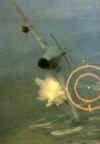
NVAF MiG-17 downed by an F-105D
flown by Maj. Ralph Kuster, USAF
June 3, 1967
How about SAMs?
What kind of defensive suite did you have in the F-105 or F-4? How did you
get alerted that you were being engaged? How did you defeat the various threats?
We just got the first RHAW gear when I arrived at Korat. The APR-25/26
supplied a tone in the headset, a light on a tele-light panel and a strobe on a
small vector scope—depending upon the frequency and pulse of the tone you
could tell what type of radar was looking at you. The tele-light panel
showed SAM, AAA, EW and MiG radars along with an “activity” and “launch”
light to warn of missile firing. The vector scope displayed a direction
for the threat and a relative strength of the signal.
The first generation of Wild Weasels, the F-100F, was in place at Korat when I arrived. They weren’t very compatible with the 105 since they didn’t have a good radar, they had no independent nav such as INS or Doppler, and they operated about 100 knots slower than we liked. We got the 105F Weasels in late May and they quickly became very effective at attacking SAM sites.
There’s quite a bit of detail about SAMs and Weasels in the book. And, since I spent most of my F-4 tour in the “killer” role in F-105G/F-4E Hunter-Killer teams, there’s going to be a lot more discussion of SAM dancing.

"First In" by Keith Ferris
(Courtesy of WildWeasels.org)
Did you see coordinated air defense tactics between SAMs, AAA and MiGs? How'd they do it?
Absolutely! They were well coordinated. A lot of the guns were radar guided. The heavy guns were radar aimed and the lighter guns were alerted and pre-directed to lay barrages in coordinated sectors. When the guns open up just as you start the pop-up in the target area and when the flak is so thick that you can’t see across the formation, you know the defense is integrated. Mixing MiGs and SAMs without fratricide is not a simple task.
SAM tactics were continually developing. They quickly went from the classic sequence of launching described in the Soviet manuals dating back to Gary Powers’ shoot-down to much more creative application. They learned to feed data to the missile by hard wire prior to firing, they learned to fire in pairs or more, they learned to coordinated several sites to support each other and they learned to fire ballistically and then take control for guidance after booster drop-off. We learned to stuff Shrikes down their throat and cover the site with CBU anytime we could find them. I wouldn’t want to have been a SAM crewman.
The 105 held the distinction of being the fastest airplane in the world below 10k feet at that time. The only way a MiG could beat us is through an unseen intercept or if we were foolish enough to try to dog-fight with them. If they didn’t kill on the first contact, we could simply run away. If they blundered out in front of us, we shot them. Unfortunately, we didn’t have good air-to-air training in those days and we didn’t know much about mutual supporting tactics. It was only by the end of Linebacker that we were really beginning to teach the concepts of good BFM and fluid attack. There were always good fighter pilots, but we lost a lot of guys because of lack of training for the rest. The “welded” fighting wing thinking of WW II and Korea cost a lot of guys their freedom for five or six years.
How would you rate the skill of the North Vietnamese pilots or AAA crews?
The gunners and missile crews were incredibly disciplined and effective. The MiG crews were good, but were hampered by the Soviet close-control doctrine that didn’t really offer them much flexibility. Think about it—if you had a light, maneuverable airplane and had strings of enemy aircraft appearing over your airfield twice a day, how many could you shoot down?
What was the typical weapons loadout on the F-105 for missions up North? How did that change during your tour with the Weasel tasking?
In ’66, the Secretary of Defense who later wrote a book trying to cover his ineptness, was lying to the American people that we didn’t have a bomb shortage. There was no “typical” weapons load for the 105 in those days. We would have liked 8 M-117 (750 lb) or 8 Mk-82 (500 lb) as a standard. Occasionally they were available, but I also saw missions going into North Vietnam with 20mm gun only—no external ordinance at all! We flew quite a bit with two M-118 (3,000 lb) bombs. I flew with four LAU-3 rocket pods. I flew with six BLU-27B finned napalm. I carried CBU-24, MLU-10b land mines and Mk-83 (1,000 lb) bombs. I also carried the AGM-45 Shrike when flying with F-100F and 105F Weasels. Rarely we carried a pair of AIM-9B Sidewinders on the outboard stations. There were instances in which a flight of four would carry two 750 pound bombs each—the primary goal apparently being to keep up sortie count to match the Navy.
During Linebacker I/II, we had plenty of ordnance. The F-4E always had three AIM-7E/2 Sparrows and an ECM pod in the right forward missile well. On Hunter/Killer sorties we carried four CBU-52 or 58—two on each inboard TER and three tanks. We would always blow the C/L tank on ingress, but would try to bring the O/B tanks home. We would drop 1, 2, or 4 CBU depending upon where in the mission timeline we were when we attacked a site. We always tried to keep some ordinance until the end of our TOT.

"Thud Ridge" by Jim Laurier
(Courtesy of AviatorArt.com)
What did you think of relative tactics of the different F-105 wings? I’ve read that one group tended to go in low, loose, fast, and weaving all the way, while the other preferred tighter, higher altitude formations. True?
Tactics change. In ’66 the two 105 wings had a slightly different approach. Korat mostly did mid-altitude ingress in a tactical spread. We stressed good lookout, early target acquisition and getting back into formation as soon as possible off the target. We didn’t do post-strike road recce in Pack VI. Tahkli liked low altitude ingress and they were known for looking for strafe targets on egress. They lost a lot more airplanes than we did during the period. We believed that a $5 million airplane wasn’t a good trade for a $10k truck.
In ’67, both wings went to pod tactics with high altitude resolution pod formations. The pod roll-in soon developed with 12 or 16 ship formations rolling into a dive bomb pass and dropping on the lead’s bomb release.
By ’72, we had better pods so the “gorilla” roll-in was gone. We used a lot of chaff in high-threat areas. We also had the first generation LGBs and EOGBs.
Did you do any level radar-aided or sky-spot bombing? What did you think of those tactics?
Yes, I did one or two Skyspots. They suck. The best that could be expected is that all bombs would hit the ground. I didn’t get involved in Ryan’s Raiders or Combat Martin or the T-Stick II programs for the 105. I did do a couple of close formation level drops in permissive areas with the LORAN ARN-101 F-4s in ’72.
What was the typical delivery? Did each jet attack individual targets, or did an entire flight roll in on one? Did everyone do their own aiming, or did you pickle off of lead's bombs?
I fortunately missed the pod roll-in period. In the 105, all of our deliveries were high angle dive bomb. It was left to the individual crew-member to determine if they wanted to use 30 or 45 degree and we could select our release altitude. A good rule of thumb is that your minimum release should be dive angle times 100 feet. So, a 30 degree dive releases at 3,000 AGL, 45 degree at 4,500 feet. It even works down to 10 degree at 1,000 feet. Using that rule, you actually get the same sight setting—simply note your dive angle and you’ve got your release altitude.
In the F-4E, Korat was probably the best at tweaking the Dive Toss system. The Korat E’s could drop better bombs than even the most experienced manual bomber. I was skeptical when I first got there, but was soon convinced. Unfortunately there were a couple of problems when trying to use it in Hunter/Killer. You had to preset the number of weapons to be released prior to radar lockon, so you couldn’t quickly choose how many CBU cans to drop. And, more important, it was possible to be too close to the target for the system to settle and compute a release. The first time it happened, we had a SAM site right next to Phuc Yen Air Base. We had him cold, but the CBU didn’t come off the airplane because I was inside the solution. I never again trusted Dive Toss for that kind of work.
Did you ever use the F-105’s cannon in combat? If so, tell us about it.
Never in air-to-air combat. The gun was good though. The lead computing gun sight gave excellent range and lead computation for air-to-air. We were scheduled for six dart sorties during training and you needed two kills of the dart (towed air/air target) to qualify. I killed the dart on my first pass of the first sortie with the gun. I got the dart on the second sortie as well—then since I was qualified, I didn’t get to fly the other four dart sorties. Two kills on two tries by someone who has never shot air/air before means a pretty good weapon.
As an air/ground weapon, the gun was fun. It was comfortably loud and one of the neatest things was that the gun mounted on the lower left side of the fuselage would vent the cordite gases into the left intake and the smell of gunpowder would come through the pressurization and air-conditioning system so you could smell it in the cockpit.
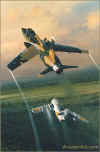
"Lethal Encounter" by William S.
Phillips
(Courtesy
of AviatorArt.com)
How much different was the combat environment between your two tours?
The losses during the 105 tour made it incredibly intense. Returning to Korat in ’72 near the end of the war, the impression was one of a war that would go on forever. The second tour was one of neon lights, prostitutes in bars, party suits, fancy stereos, excessive posturing as warriors, platform shoes and polyester double knit suits.
What did you do after your first tour? Why did you go back for a second?
The AF wasn’t sure what to do with F-105 lieutenants. We were high in fighter experience but low in flying hours. Most of us were sent to Training Command to become IPs for undergraduate pilot training. I went to Williams AFB where I’d been a student and became a T-37 IP. I went to Academics after a year and then after three years got asked to come to Training Command Hq at Randolph AFB outside of San Antonio. I worked for about 18 months in the headquarters and then wangled a short-course checkout in the F-4.
Reasons for going back for a second tour are complicated. Clearly we weren’t concerned with winning the war, and it was readily apparent that Americans didn’t really care. I had wanted to be a fighter pilot for as far back as I could remember. I had been one and had survived an incredible tour. If I were ever going to get back into fighters it would have to be while the war still went on. I was able to get the job and I was happy that I could escape from the routine of a staff job. In the book I describe flying fighters as “stealing hubcaps.” When I was a teen-ager, we stole hubcaps, not because we particularly needed them, but because of the adrenaline rush. That’s what flying fighters is about. For some it might be patriotism, but for a lot of us, it’s the thrill.
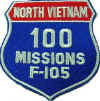
100-mission patch

100-mission party. Ed Rasimus on right.
How were you received coming back to America? Did you experience any of the "stereotypical" Vietnam homecoming issues?
I never had a problem. I was a bit miffed when I arrived back in the states after the 105 tour and found out that I was too young to rent a car from Hertz. While I was at Williams from ’67 to ’70, I went around the community to a lot of clubs like the VFW, Lions, and Rotary as well as a lot of corporations like Motorola and Hughes to speak about flying in the war. I was always well received and never encountered the slightest bit of negativism.
What did the average guy think of the Jack Broughton court martial when it happened?
Col. Broughton made a serious mistake. He knew what he was doing and what the results might be. Almost anyone might have done the same thing—defended the guys who work for you—particularly if one considers the frustration of the war rules and the bureaucracy at the moment. Unfortunately, he picked the wrong fight and chose the wrong way to wage it.
Broughton’s first book, Thud Ridge, spends a bit of time extolling the courage and virtues of his wing at Tahkli and demeaning the wing at Korat. This is considered by most of the 105 drivers of the period as going quite a bit beyond normal inter-unit rivalry and kidding. He hasn’t been seen at a River Rats Reunion for years and many folks have indicated that he isn’t all that welcome. It’s too bad.
How did you feel about the ROE and target selection during your two tours?
There’s a chapter in the book talking about the ROE in ’66. It was plainly stupid. The ROE book was unnecessarily complicated, overly cautious and incredibly political. There was no intention of winning the war and if there is an immorality to war, it is risking the lives of your military with no intention of achieving victory.
The ROE were continually changing and by ’72, we had much better rules and certainly a much more serious target list. I recall very well the morning of December 18, 1972, when I walked into the command post at Korat and the night duty officer showed me the list of B-52 strikes for that evening. That’s the first time the ROE began to look like a war we wanted to win.
What lessons can we learn from Vietnam and apply to our current situation?
I’ve heard it called the Powell Doctrine, but it might just as well be the Schwartzkopf/Horner doctrine as well. (It definitely isn’t Warden doctrine.) It’s simple: define your objectives, commit your forces fully, let the tactical commanders command, know what your end-game is. The objective of war is to kill the most people and break the most things first. You cannot act tentatively. And, you must not play at it.
What did you do after the war, and what do you do now?
I stayed in the Air Force until 1987. After Linebacker, I flew the F-4 in Spain, Turkey and Italy for four years. I spent three years in USAFE Hq planning exercises and four years instructing in Fighter Lead-In at Holloman. My last assignment was as an ALO with the 4th Infantry Division at Fort Carson, near Colorado Springs where I retired. After retirement, I worked for a short period with Northrop Corp. on the YF-23 program. For the last ten years, I’ve done free-lance writing and software reviewing for a number of computer magazines. I ’ve also taught political science at the local college.
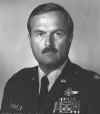
Maj. Rasimus, 1985
Just as a hypothetical, what do you think is the future of military aviation?
That’s a toughie. It’s easy to look back and we inevitably tend to the position that “our war” was the last, best, bravest, most competent one. If we look at the changes from Vietnam to Desert Storm, however, we learn a lot—and if we realize that DS was more than ten years ago, we learn even more. We now own the night and the weather is no factor. We now have incredibly integrated command/control. We now have precision munitions and phenomenal stand-off capability. We have sensors and intel and data that we never would have dreamed of in the old days.
But, the enemy also is evolving. He’s got better missiles and weapons. He’s got new tactics and methods. He’s proven he’s ruthless and not willing to fight by any knightly rules of engagement.
We need to be flexible. We need to be creative. We’re operating now at what apparently is the edge of human capability with regard to both physical and mental limits. We won’t however see the end of manned combat aircraft in the foreseeable future. We’re going to need brave man (and women) in cockpits for quite a while. Hopefully, we will remain worthy of their sacrifices.
Also as a hypothetical, is there an era of aviation, or an aerial conflict, that you have wanted to have experienced yourself? Any of particular interest?
If limited to one experience, I’d say I would have liked to fly the P-38 in combat. Mustangs would have been OK too.
THE PLANES
Besides the F-4 that you flew in your second tour, did you fly other types before/after the war. What's your comparison of the Thud to these other types? To the F-4?
The 105 was my first fighter. The F-4 my second. Here’s a little excerpt from the draft of the second book regarding the two aircraft:
You love a lot of things if you live around them, but there isn't any woman and there isn't any horse, nor any before nor any after, that is as lovely as a great airplane, and men who love them are faithful to them even though they leave them for others. A man has only one virginity to lose in fighters, and if it is a lovely plane he loses it to, there his heart will ever be.
— Ernest Hemingway, August 1944Poppa was right on. I’d lost my cherry to the Thunderchief long before I got my Phantom assignment. I’d wanted to fly the Thud from the first day I’d seen one and I’d been fortunate to have been able to meet the girl of my dreams, woo her and take her to bed in the vicious days of Rolling Thunder. I’d lost my heart, my soul, my virginity to an airplane with one seat, one engine and a gun. I’d been alone in bad guy land in the absolutely best airplane in the world and I’d been brought home safely more than one hundred times. How could one not love her?
Now I was headed to F-4 school. I’d spent the last five years sparring with Phantom drivers, sometimes seriously, sometimes jokingly about the deficiencies of their airplane and the superiority of mine. There were some deep-rooted issues regarding the views of the airplanes. On the one hand, there was the simple issue of assignment out of pilot training. I’d been fortunate enough to have the skills, the desire and, most importantly, the healthy dose of luck required to gain an assignment to a single seat fighter. The numbers told the story. There were eight undergraduate pilot training bases pumping out USAF pilots in a class every six weeks all year around. That meant about 325 new second lieutenants joining the force every month and a half of which nine would get to fly the F-105. The Phantom community was restricted at that time to experienced pilots in the front seat and new graduate pilots in the rear cockpit. In my graduating class there had been one hundred and forty guys sent to back-seat pilot duties in the F-4. It wasn’t difficult to feel a bit superior. Nine guys got laid by a queen of the prom and 140 got sloppy seconds with a fat, smoky, double-breasted ex-Navy airplane that didn’t even have a gun.”

F-4 Phantom in hot
What features did you like about the Thud? Dislike? How about the Phantom?
There was little to dislike about the 105. If you really had to complain about something, it might be the weapons switchology. It took a lot of time to set up all the switches and they weren’t very intuitive. On the other hand, the rest of the cockpit ergonomics were excellent.
The F-4’s problem was that it was designed as a two-person airplane and in a lot of areas it seemed as though the designers wanted to make sure that it was impossible for one person to operate. I hated the fact that I had to ask the back-seater for something on the radar or that I couldn’t set coordinates or change destinations on the INS. With a good back-seater that you flew with regularly, it was great, but with a temporary or a weak WSO, it was a serious handicap.
How did you like having a WSO in the F-4 after flying single-seat for so long? Did you make that transition to crew concept, or did you find it difficult?
Bad assumption in the question. I didn’t fly “single-seat for so long.” I got 120 hours in training and then flew the 105 in combat for six months. I wound up with just over 400 hours in the airplane. I then had a six year break, most of which was spent instructing undergraduate students, so being with someone else in the airplane was not unusual.
I flew the F-4 for nearly six years. In that time I flew C’s, D’s and E’s. I liked the E best since it had the best cockpit design. WSO’s come in all flavors. There are good ones and bad ones. A good one is like an extension of yourself. Things are done before you realize you want them. A poor WSO is like trying to fight with one arm tied behind your back. You not only have to contend with the enemy, you also have to drag the WSO.
In a perfect world, we would have been hard-crewed with a pilot and WSO joined for life. In practice, we were always in flux. New guys coming in would get paired with experienced guys who would leave shortly. Strong pilots would get weak GIBs and weak pilots would be assigned a seeing-eye dog to keep them alive.
I had no trouble with the crew concept. I was never one of those guys who told the WSO to go cold mike. I was often amazed at things the WSO saw in combat before I did. But I also spent a lot of time explaining to the WSO what I was doing or why I was doing or what was about to happen—time that could have been better spent. Extend the problem to managing the flight of four, not just your own airplane and it becomes still more apparent.
Peacetime WSO motivation made the problem worse. While keeping alive in combat is a good prod, getting a WSO to push the limits in peacetime is more difficult. As an F-4 Ops Officer in Spain, I would often ride in the back seat to the gunnery range as an IP. I would always drop a radar bomb from the back seat and each six months I would finish on the squadron top-gun board in the top three of the WSO’s! It was frustrating to have to ask them to “turn on the RHAW” or “why don’t you point the radar where the traffic was just called out?” or “wouldn’t it be nice to have the destination ahead of us in the INS instead of two legs behind?”

F-105 with refueling probe extended
If there’s one word that you typically think of in regards to the Thud, it’s fast. Just how fast could you go off-target? What did it take to get it there? How often did you jettison the external tanks?
In 110 combat missions, I can only recall jettisoning tanks about three times in the 105—and one of those was accidental. We almost always brought the tanks home. In the F-4, on the other hand, we jettisoned the C/L tank on every Pack VI mission. We usually brought the outboards back, but on long missions we would get rid of those as well.
As for speed, typically 600 into the target area and 600 out. I have seen as high as 750 knots outbound but that was rare. These are knots indicated. Military power—full throttle but no A/B would do 600 easily even with tanks and ordinance.
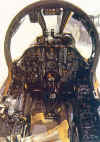
F-105 Cockpit
The F-105 also has somewhat of a reputation of being an aircraft that was unsuited for the small arms and AAA threats it faced over Vietnam. First, do you agree with that, and secondly, did you personally ever take any battle damage in the Thud? What was that like? What happened and what did you do?
High losses correlate to high threat and lots of exposure. The airplane was probably as well suited as any other of the period and arguably because of payload and endurance the 105 was better than most. The argument is often raised that multi-engine airplanes are superior to single engine, but I never saw an F-4 lose an engine to enemy action and recover on the remaining one. That works for minor malfunctions, but if the engine came apart because of flak or SAM damage, it usually meant the other engine would fail shortly thereafter.
The only battle damage I ever took was a 37mm hit to the right wing. It entered about the main gear door hinge and detonated in the wheel well blowing three holes about a foot long each through the top of the wing. I lost P1 hydraulics and the electrical wiring to the main gear downlock. I recovered at Udorn without further problems. The story is told in the book.
Unlike most current combat aircraft, with CCIP, CCRP, and other systems to aid pilots, you used “manual bombing” in the F-105 and probably the F-4, correct? Can you please talk about what it took to get a bomb on target in the F-105? Did the F-4 introduce systems to make the task easier?
Books have been written on manual dive bomb.
It’s a trig problem in a moving air mass. The basic is that the bomb
ballistics determine how fast it converts from forward vector to vertical drop.
You need to consider the angle of attack of the wing, the density altitude of
the operations, the airspeed at release, the dive angle, the altitude above the
target and the g-load on the airplane. It all takes place in a drift
relative to the target caused by the wind at release. Done perfectly you
roll into exactly the preplanned dive angle with the pipper properly depressed
and placed two or three times the final offset from the target into the wind.
The airplane accelerates, the altitude decreases, the pipper drifts to the final
release point which is offset for wind correction and when it is all done
perfectly, the bomb hits the target. Obviously in combat that gets a bit
more difficult.
As mentioned above, there are a few “rules of thumb” that help.
The dive angle x 100 lets you quickly calculate release altitude whatever dive
angle you wind up with. There are also the “tiger” rules—steep
errors are smaller than shallow, fast errors are less than slow, and low release
is tighter than high.
The Dive Toss system in the F-4E, particularly when it was fine-tuned as they did at Korat, could solve most of the problems. Put the pipper on the target and push the pickle button—the radar reads range to the target, the INS measures drift and velocity over the ground, the Air Data Computer inputs density altitude and airspeed then the Weapons Release Computer calculates when to let the bomb come off the airplane. All you had to do was a wings level pull up after hitting the pickle button—at some point the bombs would come off.
F-105s from nearby Tahkli Air Base
Can you talk about the takeoff roll in the Thud? Did you use any kind of water or alcohol injection, and if so, what did that do to complicate the typical takeoff?
We averaged about 6,500—7,000 feet of roll with a weapons loaded F-105D. Nosewheel lift-off would be around 196 and takeoff speed around 204 KIAS. We used water injection on all takeoffs. The airplane had a 36 gallon tank of de-ionized water that was injected into the combustion chamber of the engine, adding mass to the effluent. It added 2,000 pounds of thrust in afterburner. (The P&W J-75 put out 24,500 pounds in burner and 26,500 with water.)
The water tank was not stressed to hold water under flight loads, so there was an interconnect to the pressurization system. If you pressurized the cockpit, the water would dump. That meant that you had no air-conditioning until you were done with the water injection after takeoff. It could get quite hot under the Thai sun during the summer.
Operation was easy. Release brakes in full military power, throttle outboard for A/B. When the burner light, a toggle switch turned on the water. You could feel the thrust and observers could see the AB flame turn from yellow to white. Once airborne with gear and flaps up, out of A/B and you could then pressurize. You could turn the toggle switch back to off or simply leave it since any remaining water would dump.
![]()
"Big Brass Ones" by Keith Ferris
(Courtesy
of AviatorArt.com)
COMPUTERS
Most people who read the rec.military.aviation newsgroup know that you’re a familiar face there. Tell us a little bit about how you got into the online aviation community. How did you start posting in newsgroups? What’s been your experience online?
I got into home computing about 10 years ago. I made several friends on bulletin boards and they helped me with beginner problems. As the Internet explosion began, I went online and sought out areas of interest. I post to RAM regularly, but also read groups on food/wine, hunting, guns and politics.
Have you ever tried any flight simulators for the PC? Which ones? What do you think?
For six years I did software reviews for the Ziff-Davis software library. I looked at about 150 program/month. Among the categories I was assigned were flight sims. I looked at quite a few and found them remarkable although a bit overwhelming without spending considerable time familiarizing yourself with controls and scenarios. I’ve got to confess, however, that I don’t do much computer gaming and I don’t keep any flight simulators on my machine.
While working ATF (YF-23) development at Northrop, we did a lot of interactive simulation in which we merged the two dome simulators with as many as a dozen desk-top stations to fly complex mission scenarios. We could do trade-off analyses of weapons, tactics, radar cross-section and flight agility factors using staff pilots (predominantly ex-military) and active military customers. It was surprising how effective the desk-top could be for surprisingly advanced training functions such as tactics, situation awareness training and sensor operation.
For the first time in years, we are about to see a new flight sim that models the time period during which you flew, called "Strike Fighters: Project One.” It’s set in a fictional Middle East conflict, but it seems like a user-created modification for it that covers Vietnam will be inevitable. What do you hope players get out of it?
That’s hard to say. Clearly as a computer entertainment, I should say that I hope players enjoy the challenges. I wouldn’t expect the players to learn deep, philosophical insights into the causes and futilities of war, nor would I expect them to gain profound understanding into the personality and motivation of a fighter pilot.
If you were working on a flight sim, of your era or otherwise, would you aim to create a product that was “by the book” and focused on exact flight models, or one that is more “immersive,” that simulates the whole experience of the missions the plane operated in? What would be the most important factors for you to consider?
Marketing folks would tell you that your approach is backwards. You should see what the users want then build the product. If users want to experience flying the F-105, then you should build an aerodynamically accurate model with proper control response and flight characteristics. If users want a Vietnam era combat experience, then you should model defenses, targets, geography and command/control with some sacrifice in flight model accuracy.
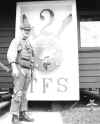
Ed Rasimus in front of squadron sign
| PURCHASE "WHEN THUNDER ROLLED" from Amazon.com  |
PURCHASE "FAST MOVERS: JET PILOTS AND THE VIETNAM EXPERIENCE" from Amazon.com 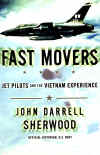 |
(C) 2002 SimHQ. Reprinted by permission